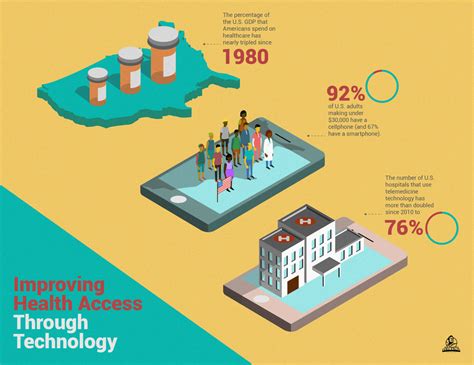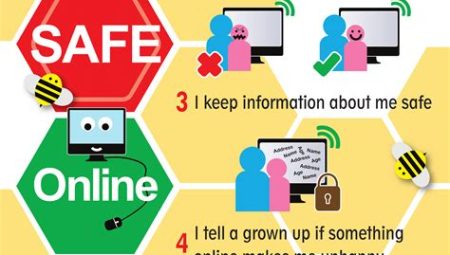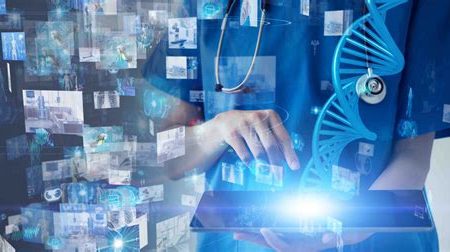In today’s rapidly evolving healthcare landscape, the role of technology in bridging gaps and improving access to healthcare has become increasingly vital. From telemedicine and wearable devices to artificial intelligence and translation tools, health technologies have been revolutionizing the way we approach patient care and accessibility. In this blog post, we will explore the various ways in which health technologies are breaking barriers in healthcare.
We will delve into the benefits of telemedicine in addressing geographical barriers, the empowerment of patients through wearable devices, and the potential of AI for early disease detection. We will also discuss how translation tools are breaking language barriers, improving access to healthcare in rural areas, and using mobile apps for remote consultations. Additionally, we will explore how telehealth is enhancing patient-doctor communication and the potential of affordable health technologies in overcoming financial barriers. Finally, we will touch on the exciting future of health technologies in bridging these gaps and improving healthcare accessibility for all.
Table of Contents
Introduction to health technologies
Health technologies are revolutionizing the way healthcare is delivered and accessed. With the rapid advancement in medical science and technology, there has been a surge in the development and utilization of health technologies to improve patient outcomes, enhance disease management, and address healthcare challenges. These technologies encompass a wide range of digital tools, medical devices, software, and applications that are designed to streamline healthcare delivery, improve patient engagement, and empower individuals to take control of their health.
One of the key aspects of health technologies is the ability to provide remote access to healthcare services, especially in underserved and remote areas. This has become increasingly important in light of the COVID-19 pandemic, where telemedicine and remote consultations have allowed patients to receive care without physically visiting healthcare facilities. Additionally, wearable devices such as smartwatches and fitness trackers have empowered individuals to track their health metrics, monitor chronic conditions, and stay connected with their healthcare providers.
Artificial intelligence (AI) has also played a significant role in health technologies by enabling early detection of diseases, personalized treatment plans, and predictive analytics. Language and geographical barriers are being addressed through translation tools and telemedicine, allowing individuals to access healthcare services in their preferred language and overcome physical distance limitations.
As we continue to witness the evolution of health technologies, it is evident that these advancements have the potential to bridge gaps in healthcare access, improve patient outcomes, and revolutionize the way healthcare is delivered.
Addressing geographical barriers with telemedicine
Telemedicine has emerged as a revolutionary tool in addressing geographical barriers to healthcare. With the advancement of technology, patients living in remote or underserved areas can now access medical care without the need to travel long distances to see a healthcare provider.
One of the key advantages of telemedicine is its ability to connect patients with specialists located in urban areas, thereby overcoming the challenge of limited access to healthcare services in rural regions. Through video conferencing and remote monitoring, healthcare professionals can provide diagnosis, treatment, and ongoing care to patients regardless of their location.
Furthermore, telemedicine has the potential to improve health outcomes by enabling timely intervention in cases where immediate medical attention is required. This is particularly crucial in emergency situations where access to local healthcare facilities may be limited.
In addition, telemedicine helps to reduce the burden on physical healthcare infrastructure in remote areas, as it allows for efficient use of resources and personnel, ultimately leading to cost savings for both patients and healthcare providers.
How wearable devices are empowering patients
Wearable devices have revolutionized the way patients monitor and manage their health. From fitness trackers to smartwatches, these technological gadgets are empowering individuals to take control of their well-being in ways that were not possible before. The ability to track physical activity, monitor heart rate, and even detect irregularities in sleep patterns has enabled patients to proactively manage their health and make informed decisions about their lifestyle.
Moreover, wearable devices have also played a crucial role in chronic disease management. Patients with conditions such as diabetes or hypertension can use these devices to track their vitals and share the data with their healthcare providers. This not only enables remote monitoring but also promotes patient engagement and adherence to treatment plans.
Furthermore, wearable devices are at the forefront of promoting preventive healthcare. By providing real-time feedback on physical activity and overall wellness, they encourage individuals to make healthier choices and stay committed to wellness goals. This proactive approach to health not only benefits the individual but also has broader implications for public health and healthcare system sustainability.
As wearable technology continues to advance, the potential for empowering patients will only grow. The integration of features such as personalized health insights, remote consultations, and early warning systems for potential health issues holds promise for a future where individuals are more informed, engaged, and proactive about their health.
Using AI for early disease detection
In today’s digital age, the use of Artificial Intelligence (AI) has revolutionized the field of healthcare. One of the most significant applications of AI in healthcare is the early detection of diseases. AI technologies have the potential to analyze large amounts of data and identify patterns that may indicate the presence of a disease at an early stage.
This is particularly important because early detection of diseases can greatly improve a patient’s prognosis. With AI, healthcare providers can access advanced screening tools that can detect subtle changes in a patient’s health, allowing for early intervention and treatment.
AI-powered diagnostic tools have the capability to analyze medical imaging, genetic data, and patient records to identify potential risk factors and early signs of diseases such as cancer, heart disease, and neurological disorders.
By harnessing the power of AI for early disease detection, healthcare professionals can potentially save lives and improve patient outcomes. As technology continues to advance, the role of AI in early disease detection is only expected to grow, offering hope for better health outcomes for individuals around the world.
Breaking language barriers with translation tools
In today’s globalized world, the need for effective communication in healthcare has become more important than ever. With patients and healthcare professionals speaking different languages, the potential for miscommunication and misunderstanding is high. Fortunately, translation tools have emerged as a solution to breaking these language barriers and ensuring that everyone can access quality healthcare services.
These translation tools come in various forms, including mobile apps, software programs, and handheld devices. They are equipped with advanced language recognition and translation capabilities, allowing for real-time interpretation of conversations between patients and doctors. This means that patients who do not speak the same language as their healthcare provider can still effectively communicate their symptoms, medical history, and concerns.
With the help of translation tools, healthcare professionals can accurately understand and diagnose patients, regardless of their language proficiency. This not only enhances the overall quality of care but also promotes inclusivity and diversity within the healthcare system. Patients can feel more confident and comfortable knowing that they can express themselves in their native language, without the fear of being misunderstood.
Overall, the use of translation tools in healthcare is a significant step towards breaking down language barriers and ensuring that every individual, regardless of their linguistic background, can receive the care and attention they deserve.
Improving access to healthcare in rural areas
Improving access to healthcare in rural areas has long been a challenge in the healthcare industry. The lack of resources and healthcare facilities in remote areas often leaves the residents with limited or no access to adequate medical care. This disparity in healthcare accessibility has significant implications for the overall well-being of rural communities.
However, with the advancements in health technologies, there is hope for addressing this issue. Telemedicine, for example, has emerged as a viable solution for providing healthcare services to rural areas. Through telemedicine, patients can connect with healthcare providers remotely, reducing the need for in-person visits that may be difficult to access in rural locations.
Furthermore, the use of mobile apps for remote consultations has made it easier for individuals in rural areas to seek medical advice without having to travel long distances. These apps allow patients to communicate with healthcare professionals, receive prescriptions, and even monitor their health conditions from the comfort of their homes.
Overall, the integration of telehealth and other health technologies is proving to be instrumental in improving access to healthcare in rural areas. By leveraging these innovations, healthcare organizations and professionals can bridge the gap between urban and remote communities, ultimately ensuring that everyone has equal access to quality medical care.
Utilizing mobile apps for remote consultations
Remote consultations have become increasingly popular in the healthcare industry, especially with the rise of mobile apps designed for this purpose. These apps allow patients to connect with healthcare providers from the comfort of their own homes, eliminating the need for a physical visit to the doctor’s office.
Patients can use these mobile apps to schedule virtual appointments, discuss their symptoms and medical history, and even receive prescriptions without having to leave the house. This convenience is especially beneficial for individuals with mobility issues or those who live in rural areas with limited access to healthcare facilities.
With the advancement of technology, these mobile apps also offer features such as secure messaging, video consultations, and the ability to securely store and access medical records. This not only improves the patient experience but also enhances the efficiency of healthcare delivery.
Furthermore, utilizing mobile apps for remote consultations can help reduce healthcare costs, as virtual visits are often more affordable than traditional in-person appointments. This can be particularly advantageous for individuals who face financial barriers to accessing quality healthcare.
Enhancing patient-doctor communication through telehealth
Telehealth has revolutionized the way patients and doctors communicate, breaking down barriers and improving access to healthcare. Through the use of telecommunication technologies, patients can now connect with their healthcare providers remotely, allowing for more frequent and convenient communication.
One of the key benefits of telehealth is the ability to conduct virtual consultations, which can be especially helpful for patients with mobility issues or those who live in rural areas. This technology enables patients to receive medical advice and treatment without having to travel long distances, ultimately improving their overall health outcomes.
Furthermore, telehealth platforms often include features such as secure messaging and video conferencing, which can enhance the level of communication between patients and doctors. Patients can easily reach out to their providers with any questions or concerns, and doctors can efficiently follow up with their patients, leading to timely and effective care management.
Overall, the use of telehealth in patient-doctor communication promotes convenience, accessibility, and improved health outcomes, ultimately bridging the gap between patients and their healthcare providers.
Overcoming financial barriers with affordable health technologies
Access to quality healthcare is a fundamental right for every individual, regardless of their financial status. However, the reality is that many people around the world face significant financial barriers when it comes to accessing essential healthcare services. This disparity has led to the development and implementation of affordable health technologies that aim to bridge the gap and provide access to necessary medical care for everyone.
One of the most significant advancements in the field of affordable health technologies is the development of low-cost medical devices and diagnostic tools. These innovative technologies have made it possible for individuals in remote and underserved communities to receive timely and accurate medical care without the burden of high costs. For example, affordable point-of-care diagnostic devices have revolutionized healthcare delivery by enabling healthcare providers to quickly diagnose and treat various medical conditions, thus reducing the need for expensive laboratory tests and imaging procedures.
In addition to medical devices, telemedicine and telehealth platforms have emerged as powerful tools for overcoming financial barriers to healthcare. These platforms enable individuals to consult with healthcare professionals remotely, reducing the need for expensive in-person visits and hospitalizations. By leveraging affordable telemedicine technologies, individuals can access medical advice, consultations, and follow-up care from the comfort of their homes, saving both time and money.
Furthermore, the development and widespread adoption of mobile health apps have played a crucial role in improving access to affordable healthcare. These apps offer a wide range of functionalities, including symptom tracking, medication reminders, virtual consultations, and access to health information. By leveraging these affordable and easy-to-use technologies, individuals can actively participate in managing their health and well-being, leading to better health outcomes and reduced healthcare costs in the long run.
The future of health technologies in bridging gaps
As we move into the future, the role of technology in healthcare is becoming increasingly important. With the advancement of health technologies, we are seeing the potential to bridge gaps and improve access to care for people all around the world.
One of the key ways in which health technologies are helping to bridge gaps is through telemedicine. By using telecommunication and information technologies, healthcare providers are able to reach patients in remote or underserved areas, allowing them to access the care they need without having to travel long distances.
Additionally, wearable devices are empowering patients to take control of their own health. These devices can track everything from heart rate to sleep patterns, providing valuable data to both patients and healthcare providers. This can lead to earlier detection of issues and more proactive management of chronic conditions.
Another exciting development is the use of artificial intelligence for early disease detection. AI has the potential to analyze large amounts of data and identify patterns that may indicate the presence of a disease or condition. This could lead to earlier diagnoses and more effective treatment plans.






